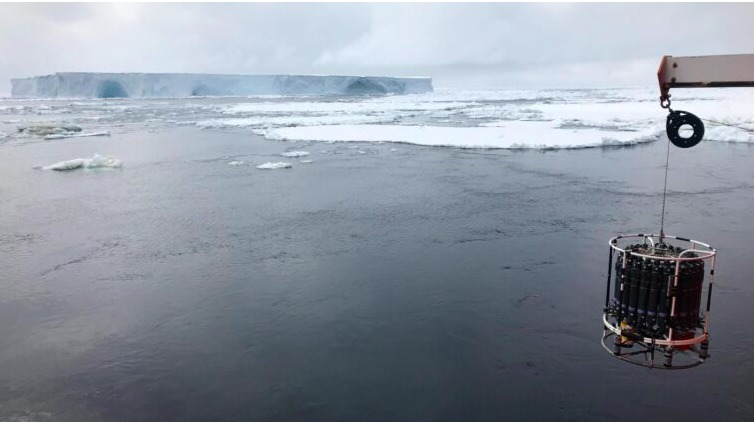
New research highlights how meltwater from Antarctic ice, driven by climate change, affects neighboring ice sheets via ocean currents. This interconnected system, studied using innovative methods including sensor-equipped seals, is key to understanding and predicting sea-level rise. Credit: Andy Thompson
Researchers have discovered that Antarctic meltwater, exacerbated by climate change, contributes to a complex network of ocean currents that influence ice melt across the continent.
Caltech researchers have used data from autonomous underwater vehicles and sensor-equipped seals to track meltwater pathways in the little-studied Bellingshausen Sea. Their findings reveal new underwater features and currents that help predict future sea-level rise by understanding these interconnected processes.
Impact of climate change on Antarctic ice shelves
Due to global warming, Antarctic ice shelves are melting at an accelerated rate. Most of the melt is coming from the lower part of the ice shelves, due to the flow of warm water beneath them. But the process doesn’t stop there: as meltwater enters the ocean, it is carried along the Antarctic coast by ocean currents, altering the melt rates of ice shelves further downstream. Mapping these melt pathways is necessary to better understand and predict melting and the resulting sea-level rise.
“We used to think of ice shelves as isolated systems, but we now know that several ice shelves are connected by currents along the Antarctic coast,” explains Andy Thompson, John S. and Sherry Chen Professor of Environmental Science and Engineering at Caltech. “What happens on one ice shelf alters processes on another. To accurately predict changes, we need to understand the domino effect they have on each other.”
New meltwater pathways discovered
For over a decade, researchers at the Thompson laboratory have been studying the Antarctic seas using a combination of techniques. A new study led by lead researcher Mar Flexas examines data collected by an autonomous underwater vehicle as well as by seals equipped with head sensors. Using this data, the team has discovered a new current that meltwater follows in a region known as the Bellingshausen Sea, on the side of Antarctica closest to South America.
“The Bellingshausen Sea is not a well-studied region, but it is the first place where warm water from the Atlantic and Pacific Oceans reaches the ice shelves,” explains Thompson, who is also Director of the Ronald and Maxine Linde Center for Global Environmental Science and Executive Head of Environmental Science. “As the ice shelves melt, the water becomes colder and softer, reducing its ability to melt.”

Deployment of an autonomous ocean vehicle, called a glider, in the Bellingshausen Sea in the Southern Ocean. Gliders measure temperature, salinity and dissolved gas concentration in the ocean. This data can then be used to monitor how the ocean transports heat to Antarctica’s floating ice shelves. Credit: Andy Thompson
The role of seal data in climate research
A decades-long collaboration between researchers from several institutions is equipping seals with small sensors that measure ocean properties as the animals move and dive in the seas in search of food. The program is called Marine Mammals Exploring the Oceans Pole to Pole (MEOP), and the data collected is publicly accessible to researchers.
By combining this data with that from the Thompson laboratory’s underwater gliders, Flexas and his team have gathered information on properties such as ocean temperature, salinity, oxygen content and particle concentration in the water in the Bellingshausen and Amundsen Seas.
Unveiling underwater currents and troughs
The team identified two distinct meltwater pathways originating from different ice shelves. One follows the coast and can accelerate the melting of downstream ice shelves by trapping warm water at depth, while the other path returns to the ocean. Interestingly, the seal data revealed a previously unknown trough, or canyon, in the seabed, which the team aptly named Seal Trough. Underwater topographical features like Seal Trough influence the flow of currents in the same way that canyons on land guide the flow of rivers.
Importance of the research and future implications
This study is an important step towards understanding how the melting of individual ice shelves influences Antarctic circulation and the melting of ice shelves across the continent. As the oceans continue to warm due to climate change, a better understanding of processes near the Antarctic coast is needed to predict future rates of global sea-level rise.
The research is described in an article entitled “Pathways of Inter-Basin Exchange from the Bellingshausen Sea to the Amundsen Sea” and appears in the journal JGR Oceans.
In addition to Flexas and Thompson, Caltech undergraduate Megan Robertson is a co-author. Other co-authors are Kevin Speer of Florida State University and Peter Sheehan and Karen Heywood of the University of East Anglia.
Funding was provided by the National Science Foundation, NASAthe JPL-Caltech internal research and
Source: Issues

